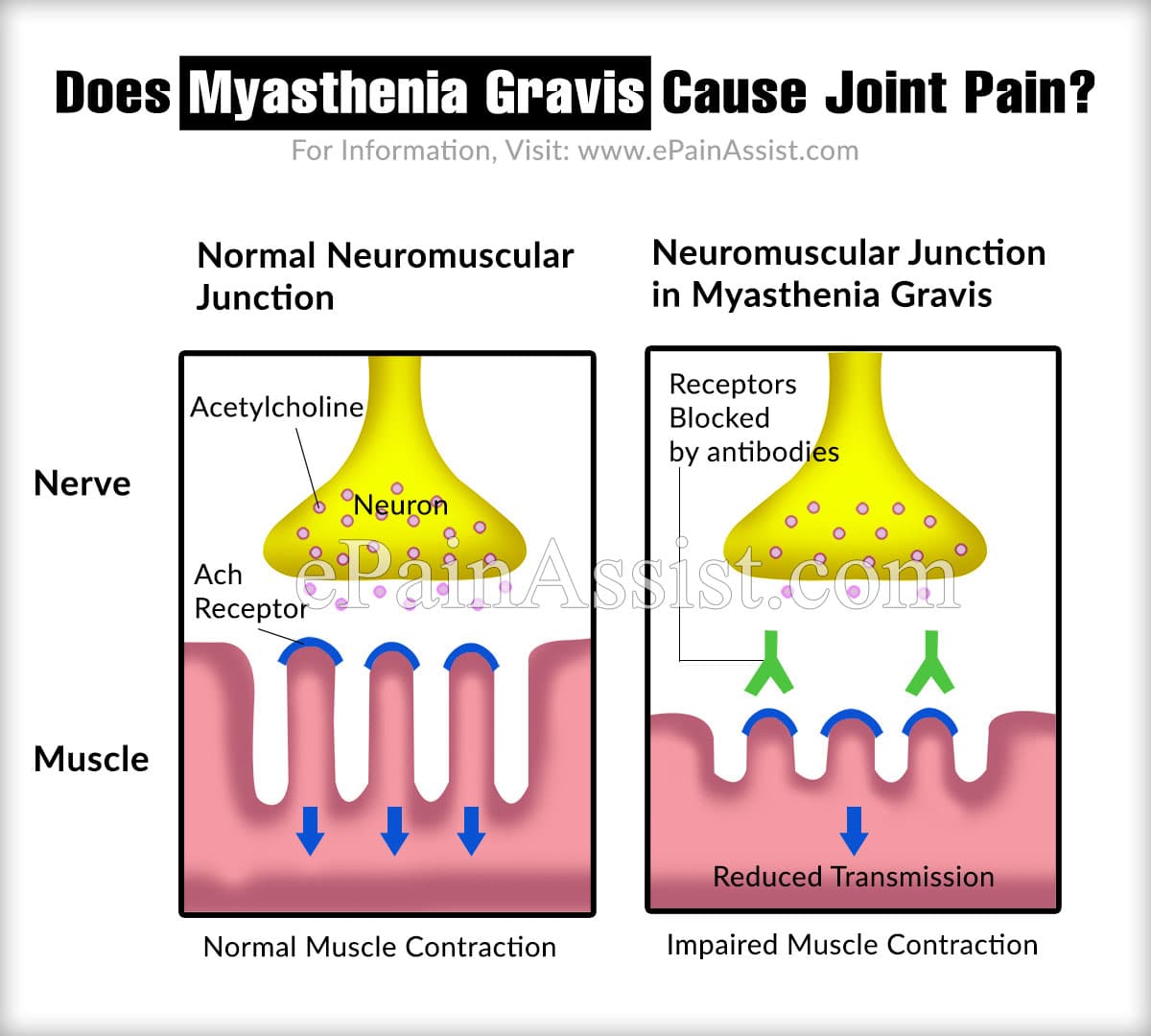Myasthenia gravis is a condition which peculiarly shows weakness and quick exhaustion or fatigue of any of muscles which you control voluntarily. This condition is caused because of lack of communication between nerves and muscles. Myasthenia gravis cannot be cured, but symptoms can be managed with treatment.

Does Myasthenia Gravis Cause Joint Pain?
Myasthenia gravis itself does not cause any joint pain. However, the muscle weakness related to a joint can cause aches and pains associated with that joint. For example, if neck muscles are weakened, there might be a pain in the neck joint or neck region due to overworking of the muscles.
Myasthenia gravis causes muscle weakness and this muscle weakness increases over time as the involved muscle is used again and again. The symptoms are seen to get better with rest. Hence, the muscle weakness can be on and off. However, classically, the condition keeps worsening as the disease progresses and becomes worse in a span of just a few years.
Myasthenia gravis affects any of the voluntary muscles. However, some muscle groups are more prone to get affected than others in this disease. The muscles that often get first involved are-
Muscles Of The Eye– Usually people with myasthenia gravis tend to have their eye muscles compromised first. The problems may include drooping of eyelids; diplopia or double vision- the double vision may be vertical or horizontal. This condition often improves when one eye is kept closed
Muscles Of The Face And Throat– In many people affected with this condition, throat and face muscles are the ones getting compromised first. The signs and symptoms may include change in speech- the speech may come out very soft or nasal, which depends upon the type of muscle being affected, difficulty in chewing- the muscles responsible for chewing may get tired easily, especially when chewing something hard, swallowing- there is a chance of choking on the morsel if the muscles responsible for swallowing get tired half way through the process, loss of facial expressions like smile etc.
Muscles Of Neck And Limbs– The muscles of neck and limbs usually get affected later than or along with other muscles in the body. Also, arm muscles are more often affected than the leg muscles. When legs are involved, it is very difficult to walk as there might be waddling. When neck muscles are involved, it can be extremely difficult to hold head in an upright position.
If there is a problem- big or small- while chewing, swallowing, speaking, breathing, walking, using hands, holding up the head, it is extremely essential to consult your doctor as early as possible. (1)
Complications Of Myasthenia Gravis
The complications seen in myasthenia gravis are mostly treatable. However, some of them may turn potentially hazardous and life-threatening. These need emergency medical care.
Myasthenic Crisis-
- This is a very dangerous condition in which the muscles performing the function of breathing become so weak that they cannot do their job properly
- This condition should be treated as emergency
- Mechanical breathing may be required in some cases
- Blood-filtering procedures and some medications may help in breathing. (1)
Thymomas-
- Thymomas are tumors of the thymus gland
- These are seen in many people with myasthenia gravis
- These are usually not cancerous or malignant
Other Complications-
- Hypoactive or hyperactive thyroid gland is a common problem seen in people with myasthenia gravis
- A problem with this gland can lead to issues with sleep, sensitivity to cold and heat, weigh gain or weight loss etc.
Other Autoimmune Disorders-
- Other autoimmune disorders are also seen in people with myasthenia gravis
- These may include diseases like lupus and rheumatoid arthritis. (1)
Myasthenia gravis makes the voluntary muscles weak. This may result in aches and pains in various parts of the body, including the joints. People may experience joint pain in myasthenia gravis because the muscles get overworked and fatigued.
References-
Also Read:
- Facet Joint or Zygapophysial Joint Pain: Causes, Symptoms, Treatment
- Joint Pain: Causes, Symptoms, Treatment, Pathophysiology, Types
- Is Vitamin D Helpful For Joint Pain?
- Can Eating Meat Cause Joint Pain?
- Joint Pain and Fatigue – What Could be the Possibilities?
- What Causes Joint Pain after Delivery, Know its Recovery Period, Home Remedies?
- Can Weather Affect your Joint Pain?
